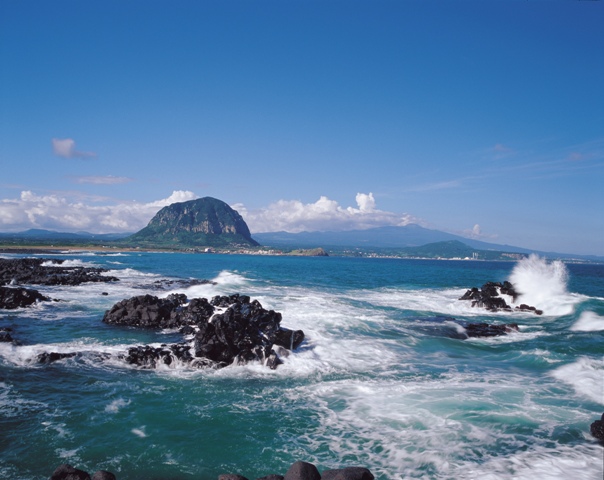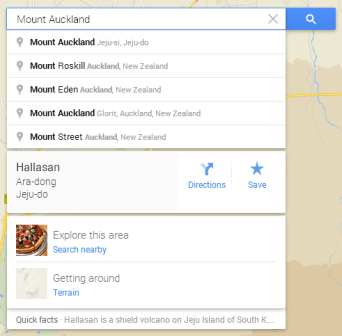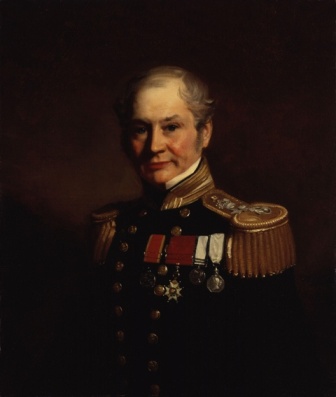|
| |
 |
|
| ▲ Many imperial powers sailed in the waters around Jeju and the British even named the land for queen and country including Mount Auckland seen in the distance here. Photo courtesy Jeju Special Self-Governing Province |
At the height of empire in the 19th century, when world powers eyed East Asia, seeking to colonize and control trade, Jeju Island came closer than one might think to becoming a Korean Hong Kong.
Up until the early years of the 20th century, Korea famously resisted the lure of the great powers, as the United States, Great Britain, Russia and, of course, China and Japan all coveted the peninsula’s strategic location.
The waters were swarming with imperial ambitions and commercial interests as Joseon (1392-1910) remained steadfast. Although the Korean prize would even-tually fall to Japan, there were many navies circling the waters, smelling blood.
The British, as was their wont, were some of the most persistent. S.J. Whitewell, in “Britons in Korea,” states that between 1795-1855, “a number of British ships explored parts of the Korean coasts and islands,” seeking markets for textiles and, possibly, opium.
What's in a name?
Most famous of these expeditions was that of Admiral Edward Belcher. A Nova Scotian by birth, he sojourned on Jeju for two weeks after arriving on H.M.S. Samarang (1843-46).
His legacy lingers as a man of empire, naming territory for queen and country, and seeing Little Englands in all distant shores, even Jeju’s.
Udo became Beaufort Island, Chagwido was Eden Island, Gapa-do was Barlow Island, Mara-do was Clifford. Jeju itself was already known as Quelpart, following earlier Portuguese explorers, but even Mt. Hallasan was Anglicized.
| |
 |
|
| ▲ A search for Mount Auckland, Jeju-si, shows that history has not been forgotten. (Also note Mount Eden, Auckland, also named by Belcher for George Eden, Earl of Auckland.) Image courtesy Google |
Search in Google maps for “Mount Auckland, Jeju-si” . If it is not yet familiar, an academic paper by R. Burnett Hall in 1926 states:
“Quelpart Island lying fifty miles south of the Korean coast may be distinguished afar by the towering peak, Mt. Auckland.”
In his log for the Samarang voyage, Belcher notes that:
“... all appears to be buried in thick forests of Pines, and other northern trees, even to the highest peak of the island, which, from our computations...reaches the height of 6,544 feet. This was named Mount Auckland.”
Belcher chose to obscure himself as the active subject of this naming, and on such an act Korean historian Kim Sun-Bae is clear: naming confers “territorial claims ... for social order and control.” (Korea is no stranger to this, as seen in Dokdo (Takeshima), Ieodo (Suyan), East Sea (Sea of Japan), and even the country itself: Hanguk or Joseon?)
Belcher wrote logs of his Jeju journey and sent them to George Eden, Earl of Auckland, who must have been pleased to learn an obscure Korean volcano was now his estate — and Chagwi-do, for good measure. Eden’s name already endowed those very British territories of Auckland, New Zealand and Eden, Australia.
Being so named nearly always portended trouble for the natives.
Korea under British occupation
Belcher arrived in the 1840s, but it took a few years for things to really heat up.
With imperial powers vying for control, in 1861 Russia attempted to occupy Tsushima, Japan, leading the British to bolster navy strength in the region to stymie further encroachment. The Great Game between the two empires was at its height, and Moscow and London both feared a spark could light the tinderbox.
Japan was itself eyeing Korea, as was a nervous China.
As tensions rose and one another’s moves were studied with precision over the next few years, a Foreign Office official in 1885 (erroneously) reported of a Korean arrangement to “cede to Russia whichever outlying group of islands the latter might prefer [for protection against China and Japan]."
This would be a strategic disaster for London, as stated by a British diplomat.
"Quelpart and Port Hamilton together would form a valuable acquisition and give Russia a position in the Japan and Chinese seas which would be dangerous (...) and very disadvantageous to our interests."
| |
 |
|
| ▲ Edward Belcher attempted to rename much of Jeju Island. Sir Edward Belcher, by Stephen Pearce (died 1904) |
The British, openly looking for a “Gibraltar of the East” to shore up interests, felt that “a condition of tute-lage...is now absolutely necessary to [Korea’s] existence as a nation.”
It was the perennial pretext for colonization.
The order then came from London to occupy Korean land, in typically stiff-upper-lip fashion: “occupy and report proceedings.”
Jeju had been spared — at the expense of Port Hamilton.
Like Jeju, Port Hamilton (Geomundo, Yeosu City, South Jeolla) had also been named by Belcher, this time for the secretary of the admiralty. Naming came first, colonization followed.
Jeju’s brush with the British was not quite over, however. The Times of London misreported that the Royal Navy had actually occupied Jeju. Diplomats around the region were sent into panic and a Foreign Office official noted:
"It is to be hoped the Admiralty have not hoisted the British Flag on the wrong island."
Britain had not, and the land of Ko, Yang and Bu was spared.
Port Hamilton spent a fairly uneventful two years under British control, with the the Union Flag being raised on Sundays, alongside a game or two of tennis. Jeju (and Beaufort and Eden Islands) remained under Seoul’s control, blissfully unaware of elevenses and cream teas.
Although the Geomun-do occupation was short-lived, the Ganghwa Treaty (a precursor to Japanese colonization) was signed during its tenure. Jeju had escaped British gunboats, but others would soon follow; it was a tumultuous time.
Jeju’s brush with the British is now just a footnote of history, leaving little for posterity except a sailor’s log book, a mistaken British newspaper article and a towering Mt. Auckland, Jeju-si, courtesy of Google maps. |






















